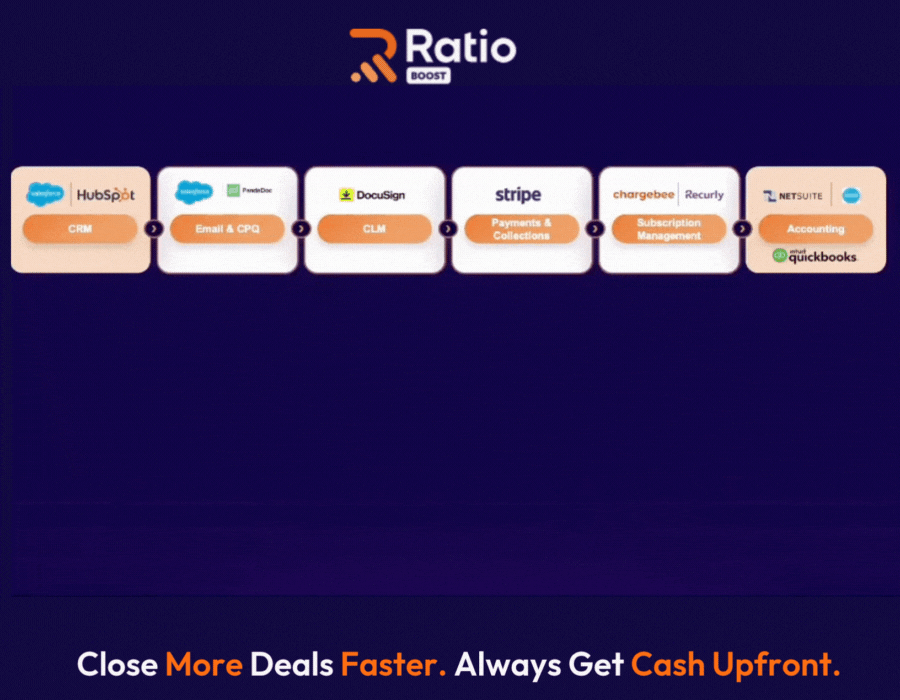The Challenge: You’re growing, you’ve invested in tools—and yet, everything feels harder to manage.
As your company grows, so do the tools.
🧾Sales adds a quoting platform to move faster.
💳Finance brings in a billing system to manage revenue.
📊RevOps implements dashboards to track performance.
Each team chooses what works for them. In fact, teams use an average of 10 tools to close deals.
But none of it works together.
📉 Deals slow down as reps jump between disconnected systems
🧩 RevOps spends hours reconciling data manually
💸 Finance loses visibility into what’s been sold, invoiced, or paid
You don’t have a tech stack—you have a stack of silos.
That’s SaaS sprawl: when well-intentioned tool adoption leads to bloated workflows, duplicated effort, and slower revenue.
In this post, we’ll break down why it happens, how it hurts SaaS growth—and how Ratio Boost unifies quoting, billing, financing, and collections into one streamlined quote-to-cash platform.
What Causes SaaS Sprawl in Sales Tech Stack?
Today, the average sales team uses 10 different tools just to close a deal. So, we believe SaaS sprawl isn’t caused by carelessness—it’s caused by well-intentioned teams trying to move fast, often without coordination.
Here’s what drives it:
1. Sales Teams Buy what Helps them Hit Quota—Fast
Reps aren’t waiting on procurement to close a deal. They start free trials, swipe cards, and download browser extensions that help them move faster.
And they do it a lot—only 12% of sales-related SaaS tools are IT-managed, meaning almost 9 out of 10 are completely unmanaged.
2. Under Pressure, Governance gets Ignored
When leadership is pushing hard to hit revenue goals, teams skip the process. They implement tools on the fly, often without approval—just to keep things moving.
This isn’t the exception—it’s routine. Departments under pressure are the most likely to adopt apps without IT involvement.
3. No One Owns the Full Workflow.
Sales buys a quoting tool. Finance adds billing. CS picks renewals. Everyone solves their own piece—but no one’s looking at the whole quote-to-cash process.
That’s how gaps form and workarounds become the norm.
4. Decentralized Buying Creates Duplicate Tools
One team buys HubSpot. Another goes with Pipedrive. Both work—but now you have two CRMs that don’t talk to each other.
This fragmented buying leads to wasted spend and siloed data, a problem G2 describes as “duplication and data disparities.”
5. Hypergrowth Adds Tools Faster than you can Integrate Them
New goals, new teams, new Ideal Customer Profile (ICP)—each adds its own tools. But nobody stops to unify the stack.
According to IBM, large orgs with autonomous divisions are the most prone to unchecked SaaS sprawl.
6. Redundancy Becomes Invisible Until it’s Expensive
The average company has 342 SaaS tools, and nearly 40% are either unused or overlapping.
You’re not just duplicating functionality—you’re paying for it twice.
All those tools might seem like progress—but they come at a hidden cost. What starts as smart, fast decisions turns into a slow bleed: longer deal cycles, lost revenue, and more time spent managing tools than selling.
Let’s unpack how sprawl quietly eats into your growth.
Hidden Costs of SaaS Sprawl—and How They Hurt SaaS Growth
You didn’t plan to create a bloated stack. But as your GTM motion matured, tools were added fast—each solving a narrow need. Quoting, billing, financing, collections, approvals... all disconnected.
Now, the stack is stitched together manually—and the consequences are everywhere. Not always obvious. But real.
Let’s break down what it’s actually costing you:
🕒 Deals Take Too Long to Close
What you see: Reps sending quotes via one tool, chasing approvals in Slack, and getting signatures elsewhere. Buyers waiting.
What it costs:
- Sales cycles stretch.
- Pipeline velocity slows.
- Reps spend more time managing the process than closing.
Root cause:
Tools aren’t connected. Your “quote-to-close” flow is really five tools and six workarounds.
Why it matters:
SaaS is a speed game. Slow deals = slower revenue = missed targets.
❌ Reps Make Mistakes in Pricing
What you see: Quotes go out with the wrong terms. Finance spots errors after deals are signed. Discounts aren’t tracked.
What it costs:
- Revenue leaks.
- Margins shrink.
- Trust between Sales and Finance erodes.
Root cause:
Pricing lives outside the quoting tool. Reps reuse old PDFs. No approvals, no version control.
Why it matters:
Scaling without pricing control breaks your business model.
📄 Invoices Go Out Late (or Wrong)
What you see: Deals close, but invoices don’t go out for days. Or they don’t match the contract terms.
What it costs:
- Delayed cash.
- Confused customers.
- Long DSO (Days Sales Outstanding).
Root cause:
Billing isn’t triggered by the quote system—it’s manual. Someone needs to “remember” to invoice.
Why it matters:
You can’t grow fast if your cash collects slowly.
🤝 Sales Promises, Finance Finds Out Later
What you see: Sales agrees to net 90. Finance expected net-30. Now AR is off, and collections are delayed.
What it costs:
- Internal conflict.
- Missed revenue goals.
- Fire drills at quarter-end.
Root cause:
No shared system of record. Sales closes in one tool; Finance operates in another.
Why it matters:
Misalignment kills both trust and cash flow.
🔁 Renewals Slip Through the Cracks
What you see: CS teams miss renewal dates. Customers churn without notice. You miss the upsell window.
What it costs:
- Lost NRR.
- Unnecessary churn.
- Reactive customer success.
Root cause:
Renewals are tracked outside CRM, often manually. No alert, no automation, no ownership.
Why it matters:
Growth doesn’t just come from new deals—it comes from keeping and expanding the old ones.
⚙️ Ops Becomes Human Middleware
What you see: Your RevOps team spends hours a week copying data between tools, fixing errors, and building spreadsheets.
What it costs:
- Burnout.
- Slow onboarding of new reps.
- Scale limited by headcount, not process.
Root cause:
Each tool works—but not together. So, humans fill the gaps.
Why it matters:
You’re throwing people at problems that software should solve. That doesn’t scale.
💬 Your Buyer Journey Feels Broken
What you see: A buyer gets a quote in one tool, a contract in another, and a payment link somewhere else. It’s messy.
What it costs:
- Slower time to close.
- Buyer friction.
- Lost deals at the finish line.
Root cause:
Sprawl isn’t just internal. It leaks into how you sell.
Why it matters:
Your product feels modern. Your buying experience shouldn’t feel like 2005.
These aren’t small leaks. They’re compounding costs that quietly lower sales velocity, drain cash, and block scale.
SaaS sprawl breaks the quote-to-cash engine that powers your business.

That’s why we built Ratio Boost—to unify quoting, billing, financing, renewals, and collections into one flow. No patchwork. No fire drills. Just speed, control, and full-cash deals closed fast.
🚀 With Ratio Boost: Reduce SaaS Sprawl Without Slowing Down
Fixing SaaS sprawl isn’t about ripping out every tool—it’s about streamlining the right parts of your stack. That’s exactly what Ratio Boost does.

Instead of juggling separate tools for quoting, billing, collections, financing, and renewals, Ratio brings them all into one seamless quote-to-cash platform—natively integrated, intelligently automated, and built for high-velocity SaaS sales.
Here’s how it works:
🔗 Connects to Your Stack.
Ratio Boost integrates with your existing CRM, billing, and payment tools—see all integrations—so you keep what works while fixing what’s broken. No rip-and-replace. No change management headache.
⚙️ Automates Every Step After the “Yes”
Billing kicks in automatically; no follow-up is needed. Collections are tracked and nudged without manual effort. Renewals don’t get lost—they get optimized. Finance always knows what’s been sold, billed, and paid.
📊 Real-Time Dashboard Across Teams
Everyone works from the same system of truth. No spreadsheet stitching. No reconciliation sprints. Just clean, real-time data across Sales, Finance, and RevOps.
🧠 Smarter Workflow. Less Stack. More Revenue.
Ratio Boost isn’t just another app. It’s how you turn your bloated quote-to-cash process into one clean, connected engine—fast, intelligent, and buyer-friendly.
💰 And Unlike Traditional Q2C Tools: You Still Get Paid Upfront.
Reps can offer flexible terms (like net 30, net 60, or monthly installments) right in the quote. Buyers get time to pay—but you still receive up to 96% of the cash upfront, powered by Ratio’s embedded B2B financing.
👉Learn more about why embedded financing is the missing piece in Q2C.
Our clients are already seeing the impact of a unified quote-to-cash platform. Take DearDoc—a fast-growing SaaS company—as an example:
- Before Ratio: They used PandaDoc, manual follow-ups, and disconnected billing tools
- After Ratio: One smart link → quote, buyer selects terms → funds arrive in hours
💥 Result: 25%+ close rate increase, fewer tools, faster revenue
Want to see how you can reduce tools without slowing down?
→ Book a live demo of Ratio’s end-to-end platform
### FAQs
1. Do I Need to Rip Out My Current Tools to Fix SaaS Sprawl?
No. The goal isn’t to replace everything—it’s to connect what you already use. Ratio Boost integrates with your CRM, billing, and payment systems to streamline your quote-to-cash workflow without forcing a full-stack replacement.
2. Is SaaS Sprawl Only a Problem for Large Enterprises Who Invest Heavily in Tools?
Not at all. In fact, fast-growing startups are often more vulnerable to SaaS sprawl than mature enterprises.
When growth is rapid, teams rush to adopt tools to solve urgent problems—quoting, billing, analytics, renewals—without centralized oversight.
Over time, this decentralized approach leads to bloated stacks, duplicate apps, and disconnected workflows, which slow revenue growth.
Sprawl isn’t about size—it’s about speed without structure.
3. How Do I Know If We Have a SaaS Sprawl Problem?
If your sales process involves toggling between multiple tabs just to send a quote, reconcile payments, or track renewals—you likely have sprawl.
Other signs include:
• Reps wasting time on manual follow-ups
• Finance struggling to get clean billing or collections data
• Tools that overlap in function but don’t talk to each other
• Delays between “deal closed” and “cash collected”
You don’t need dozens of tools to have a problem. You just need disconnected ones.


.png)




.png)


